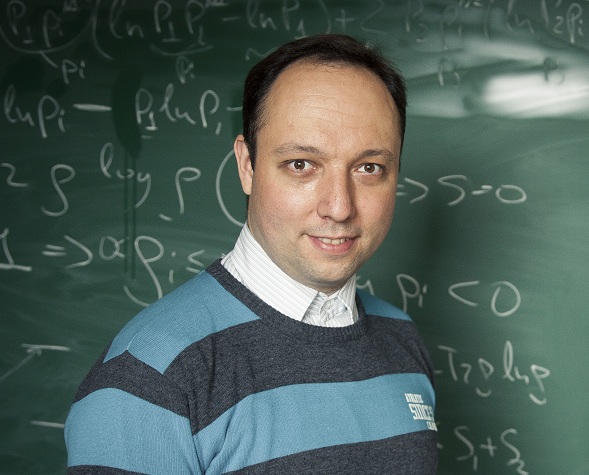Baltic Countries in focus: The personal experience of Vyacheslavs Kashcheyevs

Related topics
ICT Research & Innovation France Germany Latvia Netherlands Switzerland FET Proactive
Can you tell us a little about you?
"I am research group leader and associate professor at University of Latvia, which is also my alma mater for Bachelor and Master degrees. I have spent the formative years of my scientific career in Israel, where I did my Ph.D. in mesoscopic physics theory at Tel Aviv University and gained additional experience as postdoctoral fellow at the Ben-Gurion University of the Negev. Research and teaching are the primary outlets for my passion for physics, although I also devote a share of energy to public activities in popularizing science and enhancing the dialogue between the research community and the society at large. I am blessed to have a family and two children, aged 8 and 10, who help me not to lose a sense of wonder for the wider world around us."
Can you tell us about your research field?
"My field is quantum nanoelectronics. It is part of what is sometimes termed as the 2nd quantum revolution: the drive to develop new technology based on the laws of physics acting at the “naturally digital” level of matter. Nanofabrication and precise measurements allow controlled manipulation of individual quanta of matter (atoms and ions), light (photons) and charge (electrons and holes). One of the ambitious strategic goals is electronic implementation of quantum information processing but there are also exciting rewards along the way, such as ultra-sensitive measurement techniques, tests of fundamental concepts in condensed matter and quantum physics, and generally a wider arsenal of methods to push forward the frontier of knowledge."
What inspired you to get involved in this field?
"I am inspired by the unity of fundamental concepts in physics and the depth of unexpected connections between phenomena that skillful application of theory methods helps to uncover. Also, I profess the conviction that physics, similar to much of modern science in general, is deeply “social” in nature: networks of researchers work together towards big goals, scientists inspire and reinforce each other. The leads to “constructive interference” of their creative talents. The atmosphere of exploration, battles of ideas and people truly passionate about their work is what gives me the strongest motivation to pursue career in science.
As for my specific field, I have been lucky to get rigorous “old school” training in mesoscopic (i.e, quantum) condensed matter theory and then to meet very talented young colleagues from the experimental side of modern semiconductor nanotechnology. Collaborations that grew naturally out of my initial Ph.D. topic keep bearing fruit in terms of joint papers, new ideas and exciting research projects."
What is your focus on and main findings so far?
"One of the more tangible impacts of my theory contributions during the recent years has been the rapid increase in the speed and accuracy of the so-called single-electron pumps. These are nanoelectronic devices being developed for the needs of fundamental metrology. An important milestone for the global scientific community in the near future (2018) will be the redefintion of the international system of units (the SI) connecting the base units to fundamental physics constants and the properties of quanta. This plan includes the unit of electrical current, the ampere, which will be defined in terms of a fixed number of elementary charges per second. Single-electron pumps, acting as high-precision current sources, will help to map out the precision limits of quantum electrical metrology in context of the new SI."
As a recent example of technological advancement enabling new avenues of thought and posing unexpected questions for basic research, with my colleagues at University of Hannover (Germany), we performed an experiment on partitioning of electron pairs generated by an electron pump in a semiconductor chip (article published in Nature Nanotechnology: 10, 46–49 (2015)). We have been able to show that our electronic analogue of a quantum optics setup can behave in a distinctively non-linear way, which is opposite of what one expects based on same-sign charges and quantum statistics of electrons."
What is your experience as working in a FET project?
"I am a partner of the FET Proactive project Silicon on Atomic and Molecular Scale (SiAM) which aims at exploiting in future ICT devices and circuits the atomic nature of dopants used throughout microelectronics. This project, in which I am responsible for the theory and simulation workpackage, is a fantastic opportunity to work in a dynamic team of similar minded, young and ambitious researchers. There is a lot to learn, both in terms of science content and organization. I was honored to be invited into a high-powered team with greater research experience; the initial intense period of proposal writing was an positive adventure in itself. The multi-faceted experience of project partners (especially close connection to the industrial side of nanoelectronics) has broadened the perspective with which me and my students approach research in this field.
The breaking of mental barriers via cross-border collaboration is especially relevant for the Baltic Countries which still need a helping hand integrating into the European ecosystem of research and innovation. Success in high profile projects such as FET projects give positive and inspiring examples for the local scientific community. I cannot escape feeling an added responsibility as a role model for the young and aspiring researchers in Latvia.
Virtues of ambition, dynamics, healthy competition and collaboration that underlie the European framework for innovation are propagating more and more into the mindset and actions of individual researchers, their institutions and policy makers in the Baltic region. It is nice being back in the European family."
Follow Vyacheslavs' updates @SlavaVK and SiAM project @SiAM_EU
